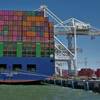The demand for ice class ships is growing. Especially tankers are being increasingly sent on transport routes in arctic and sub-arctic regions around the world. Cold and ice are a particular challenge to people and technology. The problems that arise on shipping routes through ice and how damage can be prevented was subject of an information event held by Germanischer Lloyd last week.
At the GL Exchange Forum "Operating in Ice", more than 50 participants familiarised themselves with the specific challenges facing ice class ships and icebreakers. Possible dangers and damage when operating in the frozen Baltic Sea were discussed in three presentations. The speakers made special reference to the lack of experience among crews.
Germanischer Lloyd attends to more than 2600 ice class ships, as Lutz Müller explained in his introductory remarks, making GL the market leader in this category. The Director Ship Newbuilding highlighted the intensive research activities in this field. For example, Germanischer Lloyd was decisively involved in the development of the "Guidelines for Ships Operating in Arctic Ice-Covered Waters" for the IMO, which went into force at the beginning of the year, and is the only classification society actively involved in the SAFEICE European Union research project. "Knowledge is the key to safe navigation in ice," said Müller.
Seppo Liukkonen, Station Manager of Germanischer Lloyd in Helsinki, also emphasised this aspect. He vividly showed ice damage such as to rudders and propellers, as well as drastic deformations to the ship's hull, for example the "hungry horse look", where the steel of the hull arches inward under extreme conditions and makes the frame look like ribs. However, the greatest dangers are from collisions, whether between a ship and an icebreaker or when navigating in a convoy. Large cracks and holes or damaged deckhouses are not a rarity here. A smokestack may also be adversely affected in the process.
So, what has to be done to avoid such things? "A great deal of the damage to propellers and rudders is the result of inexperienced crews," explained Kimmo Juurmaa from Deltamarin Contracting LTD. After all, ten percent of the ships deployed in ice between 2002 and 2003 came away with related damages. Juurmaa emphasised the important role played by rules in shipping traffic under these extreme conditions: "The winters on the Baltic Sea were really mild in the last four years. We therefore had more traffic and more inexperienced crews on ships with a lower ice class."
Special training for navigation in ice is currently being developed by Deltamarin. Juurmaa promised that there would "soon be the first pilot project." In spring 2007, actual planning of the special course will begin. Here, Deltamarin also hopes for support from Germanischer Lloyd.
Atso Uusiaho from Finnish icebreaker shipbuilders Finstaship also complained about the lack of experience among young crews. In his series of presentations, he referred to the increased demands: "The goal today is to make sure that as many ships as possible can get by without the help of icebreakers." To accomplish this, increased attentiveness is necessary onboard as well as expert interpretation of satellite images. Like the previous speakers, he supported intensive forms of training. "So far, it has only been possible to learn on the job," complained Uusiaho. His hope for the future is for only certified personnel to operate in ice-covered regions.
Finally, Uusiaho referred to the planned BIMWeb (Baltic Sea Icebreaking Web), where up-to-date information about icebreaking in the entire Baltic Sea regions will soon be available. At the national level (Finland), the site is already up at www.baltice.org.
Featured videos

Tracking Foreign Vessels Working in the U.S. Jones Act Market

Inmarsat Enhances Service to Drive Digitalization

Inside the Electrified Truckable Tug
Subscribe for
Maritime Reporter E-News
Maritime Reporter E-News is the maritime industry's largest circulation and most authoritative ENews Service, delivered to your Email five times per week









